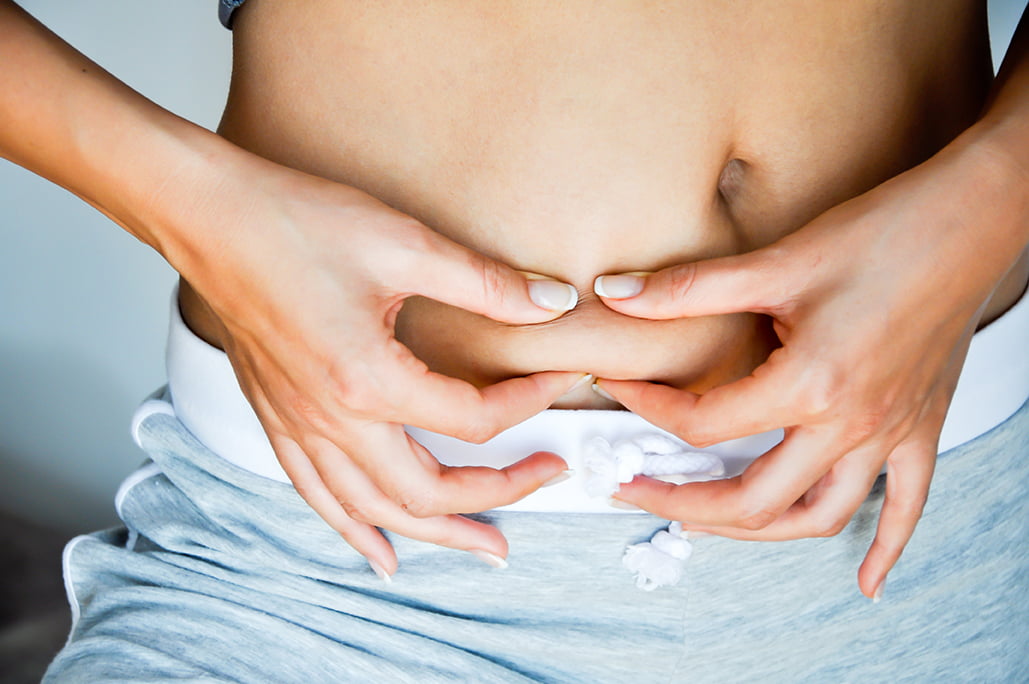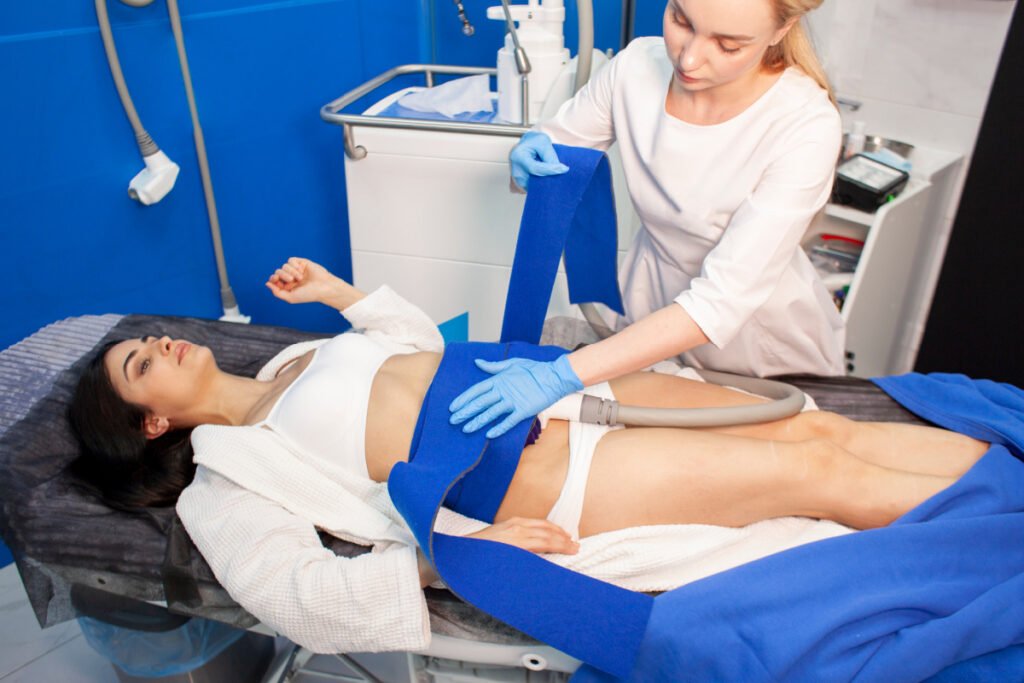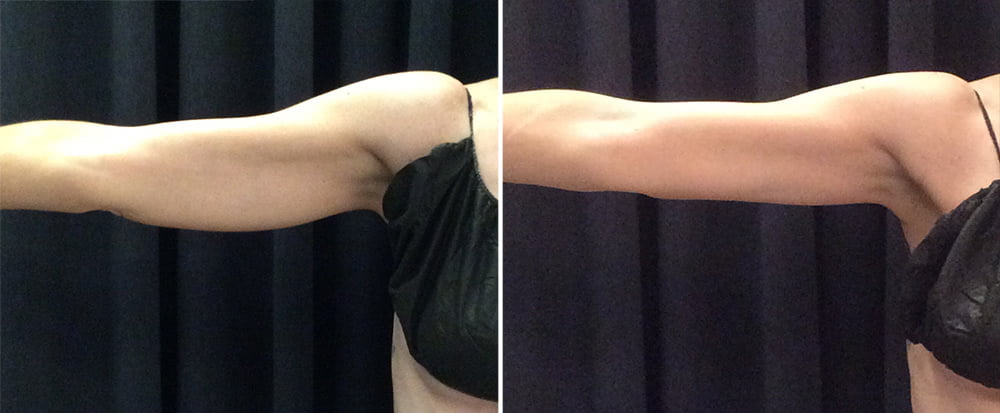How Worried Should I Be About Paradoxical Adipose Hyperplasia?

Learn More About the Rare “Stick of Butter” Side Effect of CoolSculpting®
Technically known as cryolipolysis, Fort Worth CoolSculpting® is one of the fastest-growing non-surgical procedures to spot-reduce stubborn pockets of fat. It can be used on many parts of the body, though it is perhaps most commonly used on the abdominal wall.
The skin and underlying fatty tissue are gently suctioned into a specialized applicator, which then lowers the temperature of the tissue between two cooling plates to -10ºC, freezing fat cells without harming surrounding skin, nerves, or blood vessels. The fat cells crystalize, disintegrate, and permanently leave the body as waste.
While this “fat-freezing” treatment delivers dependable results for the vast majority of patients, there is a rare potential complication called paradoxical adipose hyperplasia (PAH). The complication became a hot topic in 2015, when supermodel Linda Evangelista publicly revealed she had developed PAH. In 2022, the model settled a lawsuit against the makers of CoolSculpting, which she claimed left her “brutally disfigured.”
You should be aware of PAH before undergoing a CoolSculpting procedure, but thankfully, it is both rare and treatable.


What is paradoxical adipose hyperplasia (PAH) after CoolSculpting?
Paradoxical adipose hyperplasia is a rare complication of CoolSculpting that gets its name from the unexpected, paradoxical result: overgrowth (hyperplasia) of fatty (adipose) tissue. This complication, which can appear 8 to 24 weeks post-procedure, occurs when the treated area becomes hardened and visibly enlarged. The term “stick of butter side effects” refers to the shape the affected tissue takes, which reflects the shape of the CoolSculpting applicator.
According to a 2021 study, incidence rates of PAH were reduced by 75% with the newer CoolSculpting applicators, like those we use at our medical spa.
How does PAH look and feel?
A 2014 study published in JAMA Dermatology describes the appearance of PAH as “a sharply demarcated, rectangular enlargement around the umbilicus corresponding to the treatment zone.” The soft tissue protrusion is pliable, mobile, and slightly tender to the touch, feeling like a hardened fat lump after CoolSculpting.
How common is the “stick of butter” side effect of CoolSculpting?
The “stick of butter” side effect is not common. Our practice has been offering CoolSculpting for many years, and we have not had any cases of PAH among many hundreds of patients. However, estimates range from 1 in 20,000 procedures to 1 in 256:
- According to 2024 data from Allergan, the manufacturer of CoolSculpting, PAH occurs in 1 out of every 3,000 CoolSculpting treatment cycles, which is an incidence rate of 0.033 percent based on all reported PAH cases since 2015.
- A 2021 review published in Aesthetic Surgery Journal found that PAH occurred in 1 in 256 cases performed at 8 Canadian medical centers between January 2015 and December 2019.
- A 2014 study published in JAMA Dermatology found that this side effect has an incidence of 0.0051% or about 1 in 20,000 treated patients.
The odds of developing PAH are likely very low at a practice like ours with up-to-date technology and highly trained providers. The 2021 review also found that rates of PAH were reduced by over 75% with the use of newer CoolSculpting applicators and units.
In rare cases, CoolSculpting may lead to a side effect known as paradoxical adipose hyperplasia (PAH), or unexpected fat growth after CoolSculpting.
- Overview
- Glossary
- PAH is an overgrowth of fatty tissues
- May occur in 1 in 4,000 to 20,000 cases
- Treatable with liposuction
- Kalos Medical Spa has never had a case of PAH
- CoolSculpting: A cosmetic procedure that uses intense cold to reduce fat deposits in certain body areas. CoolSculpting® is FDA-cleared to treat visible fat bulges in 9 areas of the body. Some common side effects include temporary numbness, discomfort, and swelling.
- Cryolipolysis: A non-invasive fat reduction technique that freezes and destroys fat cells.
- Liposuction: A surgical procedure to remove fat from specific areas of the body.
- Fat Cells: Cells in the body that store fat. During CoolSculpting, treated fat cells are targeted and destroyed by the intense cold temperatures that break down fat.
- Side Effects: Unintended effects or reactions that may occur as a result of a medical procedure or treatment. Serious side effects are rare after CoolSculpting.
- Subcutaneous Fat: Fat located under the skin, often resistant to diet and exercise. This is the “stubborn fat” or “unwanted fat” targeted with CoolSculpting.
- Breast Implants: Medical devices inserted under the breast tissue and/or chest muscles to increase breast size.
- Treatment Site: The specific area of the body where a medical or cosmetic procedure is performed.
- Recovery Time: The period required for a patient to heal following a medical procedure.
- Paradoxical Adipose Hyperplasia: A rare condition where treated areas increase in fat volume following cryolipolysis.
- Fat Freezing: Another term for cryolipolysis, where cold temperatures are used to break down fat cells.
- CoolSculpting Alternatives: Other procedures or treatments available for fat reduction besides CoolSculpting.
- DualSculpting: Using two CoolSculpting machines simultaneously to treat multiple areas at once.
- CoolTone: A procedure that uses magnetic muscle stimulation to strengthen and tone muscles.
- Nonsurgical Fat Reduction: Techniques to reduce fat without surgery, such as cryolipolysis or laser treatments.
- Consultation: A meeting with a healthcare provider to discuss treatment options and goals.
- American Society of Plastic Surgeons: A leading organization representing board-certified plastic surgeons.
- Board-Certified Plastic Surgeons: Surgeons certified by the American Board of Plastic Surgery, one of the 24 medical specialty boards recognized by the American Board of Medical Specialties.
- Food and Drug Administration (FDA): The U.S. federal agency responsible for regulating food, drugs, and medical devices.
- Paradoxical Adipose Hyperplasia (PAH): An increase in fat volume in the treated area after cryolipolysis.
- Noninvasive: Procedures that do not require incisions into the body or removal of tissue.
- Body Contouring or Body-Contouring: Cosmetic procedures that alter the shape of the body to achieve a desired appearance.
- SculpSure: A non-invasive laser treatment for fat reduction.
- Visceral Fat: Fat located within the abdominal cavity, surrounding internal organs. This fat is not treatable with CoolSculpting, which targets the “white fat” or subcutaneous fat below the skin.
- Microdermabrasion: A cosmetic procedure that exfoliates the top layer of skin to rejuvenate its appearance.
- Clinical Trials: Research studies conducted with human volunteers to evaluate medical interventions.
- Tummy Tuck (Abdominoplasty): A surgical procedure to remove excess skin and fat from the abdomen and tighten muscles.
- Obesity: A medical condition characterized by excessive body fat that may impair health.
- Adipose Tissue: Body tissue that stores fat, providing insulation and energy reserves.
- Interstitial Cells: Cells found in the spaces between organs and tissues that perform various functions.
- Zeltiq Aesthetics: The original company that developed CoolSculpting technology.
- Cryolipolysis Treatments: Procedures that use cold temperatures to reduce fat by destroying fat cells.
- Bra Fat: Excess fat that accumulates around the bra area, often targeted for cosmetic procedures.
- Hypertrophy: An increase in the size of an organ or tissue due to the enlargement of its cells.
- Breast Augmentation: A surgical procedure to increase breast size, often involving implants.
- Preadipocytes: Precursor cells that can differentiate into fat cells under certain conditions.
Does paradoxical adipose hyperplasia go away on its own?
Paradoxical adipose hyperplasia is not physically dangerous, but it will not go away without treatment. Typically, patients have to wait up to six to nine months for the fat in the affected area to soften enough to be removed safely using liposuction—otherwise, there is a risk that PAH could reoccur.
If you have had a CoolSculpting procedure and feel you may be experiencing the “stick of butter” side effect, it is important to inform your provider about your possible CoolSculpting complications so that they can examine the area and recommend next steps.
How is PAH treated?
Paradoxical adipose hyperplasia does not typically resolve on its own, but is quite treatable with liposuction. In some cases, multiple procedures may be needed to achieve optimal results.
There are also no known negative effects on the overall physical health of patients after PAH has resolved.
Who is prone to paradoxical adipose hyperplasia?
Studies have not found any specific population to be more prone than another to developing this side effect.
References »
Jalian HR, Avram MM, Garibyan L, Mihm MC, Anderson RR. Paradoxical adipose hyperplasia after cryolipolysis. JAMA Dermatology. 2014 Mar;150(3):317-9. doi: 10.1001/jamadermatol.2013.8071.
Singh SM, Geddes ER, Boutrous SG, Galiano RD, Friedman PM. Paradoxical adipose hyperplasia secondary to cryolipolysis: An underreported entity? Lasers Surg Med. 2015 Aug;47(6):476-8. doi: 10.1002/lsm.22380.
Ponga-Manso M. Ultrasound assessment of abdominal adipose panniculus in patients treated with a single session of cryolipolysis in a clinical setting. Journal of Cosmetic Dermatology. 2022 Jan;21(1):307-315. doi: 10.1111/jocd.14597.
Hetzel J, Awad N, Bhupalam V, Nestor M. Cryolipolysis in the United States-Review of the clinical data. Journal of Cosmetic Dermatology. 2023 Nov;22 Suppl 3:8-14. doi: 10.1111/jocd.16029.
Kelly, Michael E. M.D.; Rodríguez-Feliz, Jose M.D.; Torres, Carolina M.D.; Kelly, Emma B.A. Treatment of Paradoxical Adipose Hyperplasia following Cryolipolysis: A Single-Center Experience. Plast Reconstr Surg 142(1):p 17e-22e, July 2018. | DOI: 10.1097/PRS.0000000000004523
Hwang IC, Kim KK, Lee KR. Cryolipolysis-induced abdominal fat change: Split-body trials. PLoS One. 2020 Dec 29;15(12):e0242782. doi: 10.1371/journal.pone.0242782.
Resende L, Noites A, Amorim M. Application of cryolipolysis in adipose tissue: A systematic review. Journal of Cosmetic Dermatology. 2022 Oct;21(10):4122-4132. doi: 10.1111/jocd.15265.
Murphrey M, Garibyan L. Cryolipolysis: The future of cryolipolysis. Journal of Cosmetic Dermatology. 2023 Nov;22 Suppl 3:37-47. doi: 10.1111/jocd.15985.
Andreas Nikolis, Kaitlyn M Enright. A Multicenter Evaluation of Paradoxical Adipose Hyperplasia Following Cryolipolysis for Fat Reduction and Body Contouring: A Review of 8658 Cycles in 2114 Patients. Aesthetic Surgery Journal, Volume 41, Issue 8, August 2021.
Kalos Medical Spa is led by female plastic surgeon Dr. Emily Kirby. Her medical aesthetics team has many years of experience, and all of our staff who perform CoolSculpting are trained in best practices. Our licensed physician assistant Marianita Vela is a former Allergan Medical Institute Coolsculpting Faculty Trainer.
If you’re curious about non-surgical fat removal but concerned about rare CoolSculpting side effects like PAH, our experienced Fort Worth team uses the latest CoolSculpting technology and best practices to minimize risks and maximize your body contouring results.
If you would like to learn more any of the state-of-the-art services we offer for your skin, face, and body, please contact our Fort Worth med spa today at (817) 292-4200.





Alan
Well I had cool sculpting done on a small area in lower belly and it looks much worse now and it’s been 16 weeks. I now have a deformed stomach. I have to assume I am one out of the 4000 you wrote about getting PAH.
Reem
Is it treated now or the same?
Naja Hayes
I also have experienced PAH and it is horrible. I am being compensated for the corrective procedure, but not for the time I will need to be away from work to recover. I am sore afraid of this condition returning. I recall exercising more when I saw my stomach and abdomen area increase; then I thought that exercise was causing the problem. Fortunately, where I received treatment, the team was eager to help me. It is when the case goes to the insurance provider that you are then not treated responsibly.
Naja Hayes
I want to add that my procedure was not performed at Kalos. I wish it had been.
sarah carnahan
I have also had cool sculpting on my abdomen and outer thighs. It seemed to be working at first, but after 1.5 months the areas all began to get bigger and harder. I now have all three areas that look deformed and like I don’t watch what I eat or exercise. I jog every morning and eat healthily every day and yet I now have a bulge in each of these areas that was never there before and looks disfiguring. I would urge everyone to please try liposuction or simply diet and exercise- it seems to be a lot more common than the .05 percent or whatever statistic they quote. I’ve now got to figure out a way to pay for liposuction that may or may not work on the hardened, fibrous fat tissue that used to be barely an inch of pinchable fat that I could have just taken care of by working out more, I regret this more than anything and urge you to research this before acting. I also was not treated at Kalos and wish I had opted for lipo or further dietary changes.
Kalos Medical Spa
Hi Sarah, thank you for your comment. Your situation highlights the importance of choosing experienced and reputable providers for CoolSculpting. Our medical spa is closely supervised onsite by Board-Certified Plastic Surgeon Dr. Emily Kirby. It is so important to have full disclosure before any treatment, including possible risks. We urge you to contact the facility where you had your treatment, as Abbvie (Coolsculpting company) now clearly spells out their warranty and assistance with this rare complication. It is still a very rare complication, most often seen with the 1st generation of applicators, which are now defunct. Our CoolSculpting specialists maintain up-to-date training in appropriate protocols with CoolSculpting technology, and we prioritize thorough consultations with patients to ensure that all potential risks are clearly communicated and understood. We hope you get the care you need shortly!
Diane D
I feel the same, my husband thought it would be a viable easy way to treat the small layers of fat that I had residual from birthing children and my last of 3 being a C-section. Now 5 yrs later I regret doing the coolsculpting. They refunded the cost and I saw a specialist, but the cost is so high, they did compensate for some of the cost but being out of work for 8 weeks is not possible. The thought of drains in my abdomen etc. I have not had the surgery. I wish I had gone to a medical doctor for lipo.
Julie D
I have a much larger stomach now since I dod the coolsculpting. It’s hideous, being physically active, it just won’t budge. I’m another one put of the 4000.
Karen
I too have had cool sculpting resulting in PAH. You can actually see the outline of where the cool sculpting paddles were placed. I have to buy cloths that are much bulkier than I should need to cover the bulges. Don’t do Cool sculpting. I did not do tis at Kalos, but This seems to be a common side effect, based on all these comments. I guess there is some comfort in that I thought I was the only one that ever had this happen.
Nathalie
I also had disfiguring side effects in my hip/love-handles area. The left hip is like a shelf off my waist. The right size as bad but not as big as the left side. I also have discoloration everywhere the paddles were so now have to use and pay for lightening creams. I used to have a pretty straight ruler figure and now have cartoonish hips. I am so self conscious and rub the hardened fat constantly. I wish I had never done cool sculpting. The provider told me it would go away and claimed it was not PAH but it is. Major regrets on a permanent ugly effect on my body.
Lauren C
I had one cool sculpting treatment in 2018 and my life has been taken over by the side effect PAH. I required a full tummy tuck even though I never had a weight problem or had children. Some was left behind, so I then had a second liposuction and renuvion skin tightening treatment. Now there is a small area growing AGAIN. This side effect is nothing short of a life altering medical device injury that completely deforms your bodyl. Correction puts you out 10’s of thousands (70K now). It’s is truly depressing and terrible. No, Kalos did NOT do my tx, but I felt compelled to tell my story. Just get lipo from a board certified plastic surgeon. Do not risk this horrid monster fat side effect! It has been a central theme of my life now for 8 years. And unfortunately there are many others like me requiring multiple surgeries. THIS was not in my consent!
Adriana
Lauren, I developed PAH under my chin and it is soooo noticeable! I should have never done any procedure. Where did you have your liposuction done? I keep getting turned down by so many plastic surgeons and I am trying to find one to help me with this. So upset and sad! 🙁
Laura
Me realice una aeciondw cooltech en el abdomen y tengo un bulto grande, duro y con muchísimo dolor, me quema las 24 hs del día y en el centro que me lo realice dicen que es normal, pero cada día que pasa me siento peor